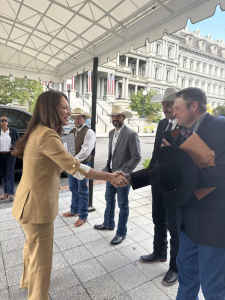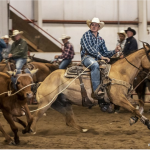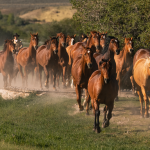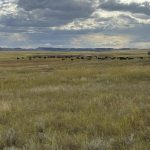Ranchers take DC: Several groups of cattle and beef producers meet with decision-makers in September
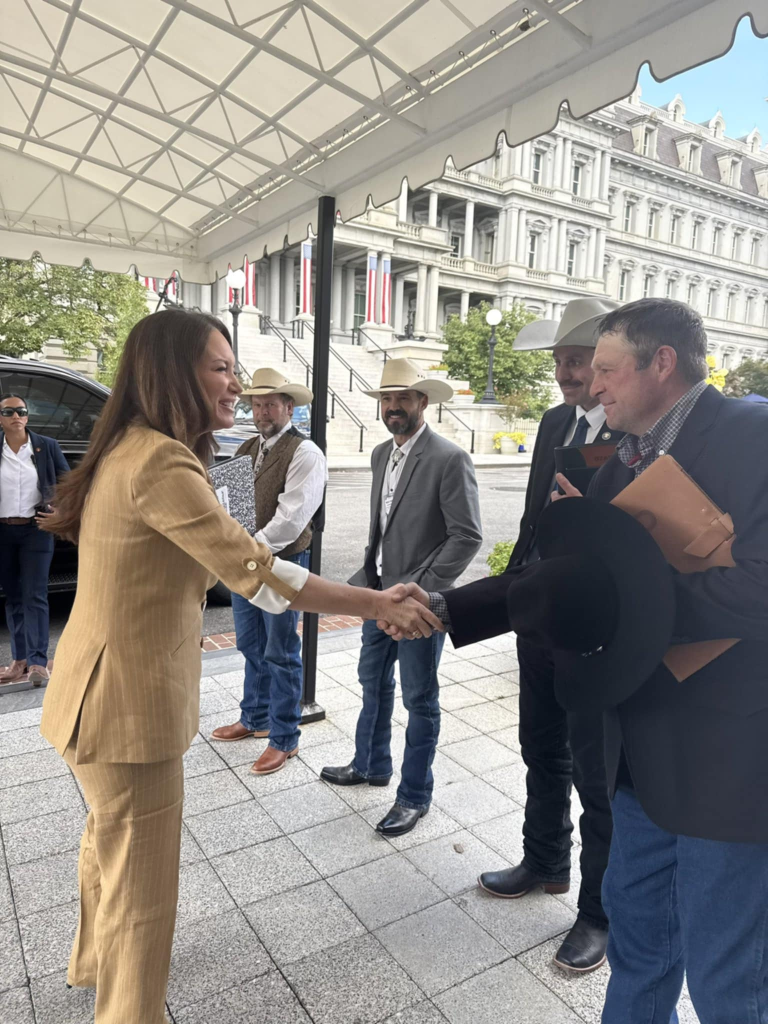
Several groups of cattle producers could be seen walking the halls of Congress and the U.S. Department of Agriculture in recent weeks. No, they weren’t lost.
They were detailing some of the ways government prevents cattle producers from being profitable and identifying solutions that could help.
Jack Payne, owner of Nevada Livestock Marketing was one of five ranchers from western states to meet with USDA Secretary Brooke Rollins to describe the drastically diminished cattle numbers on federal lands.
Grazing is needed on rangelands to maintain plant and soil health, reduce fire danger and provide economic stability to communities, said Payne.
Secretary Rollins posted on X (formerly Twitter) on Sept. 6, 2025, “Earlier this week, I sat down with some of the greatest Americans I have ever met – multi generational Western ranches who put it plain and simple: Washington has been working against them, not for them. Of the 640 million acres owned by the federal government, 35 percent is actively permitted for grazing, including 40 percent of the USDA Forest Service’s 193 million acres.
“Unfortunately, federal land ranchers are facing delays in THOUSANDS of grazing permits and historic lack of coordination across USDA and DOI who manage these lands. That stops TODAY with the Trump Administration. I have spoken directly to [US Department of the Interior Secretary] Doug Burgum and our incredible USDA and Interior teams have already begun to map solutions. More coming soon.
“These ranchers feed our families, fuel our economy, and keep America going strong. They deserve a government that has their back, not one that ties their hands.
“We’re taking action. Big changes are coming. Stay tuned,” said Secretary Rollins.


Federal lands AUM cuts
Payne said his group explained to the Secretary that the Bureau of Land Management and the U.S. Forest Service have in many cases cut grazing numbers unnecessarily. The USDA manages U.S. Forest Service land, while the Department of the Interior oversees BLM property.
A BLM report showed about two million active and about 500,000 “suspended” aums (animal units per month) in the state of Nevada in 2018. The two million aums equates to about 167,000 cow-calf pairs grazed on Nevada BLM land each year.
According to the BLM, about 14.4 million aums were permitted in 1966, and about 10.8 million were permitted in 2024.
The number of cattle permitted to graze on U.S. Forest Service land dropped from about 9 million in 1966 to about 6.6 million in 2013.
“They way I view it, they are ‘CRP-ing’ the Western United States. But we’re not paying people not to graze it. Instead we are handing it off to environmental groups,” said Payne.
Payne said one tactic to reduce grazing is for the government to adjust the grazing period to an unfriendly and difficult to use timeframe.
“On our Idaho ranch, the grazing period was originally June to October. Now it’s April to July. That is mountainous country. The roads aren’t graveled, yet they want us to haul cattle in there in April. Usually getting them hauled in May or June is even a challenge. That was one of their tactics. They knew we couldn’t get them in there in April,” he said.
“Most people feed cattle from December to April in that area. So if we are grazing from maybe May to July, that leaves four to five months with nowhere to go,” he said. Payne said he ranches in Idaho, Nevada and Oregon, on BLM land. With only around 29 percent of Idaho’s land and about 12 percent of Nevada land in private ownership, cattle ranches on private property essentially don’t exist.
“In Nevada, the private property we do have is a 40 here and an 80 there,” said Payne.
On an Idaho ranch Payne owns, the cattle numbers have been slashed from 6,000 aums to about 2,400.
Payne said that while the Idaho ranch for example could handle at least 6,000 aums, that doesn’t equate to 6,000 cows. “It should be a 6-8 month grazing permit,” he said.
A 6,000 aum agreement for June through October equated to 1,200 cows. The current, shorter agreement with 2,400 aums means Payne can graze about 700 cows for 3 and a half months.
Payne emphasized that even the 6,000 threshold was cautiously low. “It could actually handle more cattle than 6,000 aums,” he said. “But instead, they cut our numbers. Now the grass is dying. They don’t let you run enough cattle to utilize 10 percent of the grass,” he said.
“They aren’t eating half the grass right now. They are targeting their favorite plants so their less favorite plants don’t get grazed. So they get an advantage over the plants they like. By not leaving enough cattle to clean things up, we are hurting the perennials, and the undesirable grasses like cheatgrass take over,” he said.
Payne said another method of reducing aums is to sell them to non-ranchers (usually anti-grazing groups) who “retire” the grazing agreement or run the bare minimum of cattle.
Payne points out that anti-grazing self -proclaimed “environmental” groups have “made a business” out of suing over alleged infractions on federal land. An organization might file suit on 18 different things, including items like stubble height of grass. If they are found correct on just one point, they government pays the court costs via the equal rights to justice act, and cuts or eliminates the ranchers aums.
Even if no lawsuit is filed, the threat of one can impact grazing policy, says Payne. “These environmentalist types in the BLM, they might not even be sued by Western Watersheds. But they draw Western Watersheds ‘like a gun’ to threaten ranchers. The BLM is using them as an excuse for everything they don’t want to do. Everything that is pro-grazing and pro-rancher,” he said. Payne said in some cases, the BLM invites Western Watersheds to attend meetings with producers meant to determine range management plans.
Stall tactics
Payne said paperwork is often another hindrance to what he considers efficient use of public land.
“We need to get to a place where we aren’t waiting on 10 years of paperwork to do anything,” he said. “And we need the ability to use third party contractors to conduct research.”
For example, Payne has submitted requests to the BLM on wet years for non-renewable permit due to extra forage being available. But red tape prevents the request from ever being approved. “They say they are understaffed. So the answer is ‘no’ because they say they don’t have anyone to help do the study,” he said. Payne would like the approval to hire an independent third party contractor to do the measuring, etc., required to issue timely permits. “We want a third party that is not groomed by the BLM. We want independence,” he said.
Hayden Ballard, a Utah rancher and attorney who specializes in federal lands law and agricultural law via his organization Great Western Resources, said that a 2015 study from Utah State University revealed that each permitted aum on federal land in Southern Utah results in an economic impact to surrounding communities of $100 per aum per year. Accordingly, for every single retired or suspended aum, the local community loses $100 annually and the rancher also loses the fair market value of those aums.”
Payne points out that, based off that calculation, communities in Nevada, Idaho and other western states have lost millions of dollars over the course of several decades.
Ballard, who was another of the five ranchers invited to meet with Secretary Rollins, explains that the sheer volume of federal land ownership in the west is completely different from eastern states.
“Only about 19 percent of our state’s land mass is in private agriculture,” said Ballard. He said that land mass is similar to the states of Vermont and New Hampshire put together.
“If you want to raise cattle in Utah, you have to incorporate these federal grazing allotments. There isn’t enough private land to ranch without it,” he said.
Since 1976 when the Federal Land Policy Management Act (FLPMA) was enacted, the number of aums has “taken a deep dive,” said Ballard.
“We would like to see grazing restored to pre-1976 levels. I don’t know if that’s possible, but that’s the goal,” he said.
“We are trying to put a stop to those losses and increase opportunities for young farmers and ranchers in the next generation coming up. That’s the focus. It’s not about me and the other guys my age, it’s about preserving a life for my kids and hopefully my grandkids,” he said.
Ballard was excited for the chance to present his concerns to Secretary Rollins. “I was thoroughly impressed with Secretary Rollins and I believe her team is devoted to helping federal lands ranchers,” he said.
“It has been said by her detractors that America has no unique culture. I disagree. The cowboy is a living symbol that is uniquely American, but if the decline of federal land ranching continues, then at least in the west itself, this iconic way of life will continue to deteriorate. We need to restore trust and confidence in the future of federal land ranching, so that we can leave our children and grandchildren the same legacy and way of life we were so blessed to inherit.
Ballard said there are a couple of ways ranchers can help keep this issue on the forefront of their Senators’ and Congressional representatives’ list of priorities.
Support the “America First” agenda, he said. “For example, the USDA has announced the rescission of the 2001 ‘Roadless Rule’ and the BLM has announced the rescission of the so-called “Conservation and Landscape Health Rule.” Both of these rescissions are common-sense wins for our western producers, and we need to submit public comments in support of positive changes like these. In that vein, we need to, metaphorically, ‘strike while the iron is hot.’ The Trump Administration has shown a willingness to restore active management to our western forests and rangelands, so find ways to identify positive changes you’d like to see and get those ideas to your local elected officials so that we can – truly- Make America Great Again,” said Ballard.
Payne said the group discussed other cattle industry issues with the Secretary. “We talked about MCOOL. We said that if the WTO (World Trade Organizaiton) is the sticking point, let’s get out of the WTO. We talked a little about the New World Screwworm and how cattle are being used by the drug cartel. We talked about the 30-month rule being outdated,” he said.
A.J. Richards with fromthefarm.org, helped organize the gathering.
Richards, a Utah business man and ag advocate, who helped establish the fromthefarm.org website to connect producers and consumers said he himself is not a cattle producer, but many of his friends and family members are. “I’m very clear to people. I’m not the expert. But I’ve made it a point to shake the experts’ hands and get them in front of the right people so we can get the attention we need on the issues affecting this country’s food production.”
“I’m trying to get as many of these actual producers in front of the decision-makers as possible, so they can hear from the real folks, not corporations,” said Richards.
Richards spoke on a Turning Point USA food freedom panel in Florida a few months ago, donning his signature tin foil western hat. “I wear a tin foil hat on purpose. It was that tin foil hat that got me this meeting. When you have this guy saying crazy things that are actually true, it’s like a train wreck, you can’t look away,’ he said.
R-CALF USA
As it turns out, September was unofficially “rancher month” in Washington, D.C.
Several officers and others representing R-CALF USA met with a variety of Congressmen, USDA Secretary Brooke Rollins, additional USDA staff and more to seek support for what they consider key issues across cattle country.
R-CALF USA president Dave Hyde, an Ohio cow-calf producer said the group met briefly with Secretary Rollins, and spent significant time with a navy admiral working with USDA on the New World Screwworm issue due to the biosecurity aspect of the parasite.
“We thanked Secretary Rollins for her work on the Maude case, and then we talked about the crisis in the cattle industry – the loss of over half the nation’s cattle operations in the last 40 years. We urged her support for mandatory Country of Origin Labeling of beef, asked for her support for checkoff reform, Packers and Stockyards Act reform and then we talked trade and tariffs,” said Hyde.
Hyde said that over a period of 3 days, the ranchers broke up into smaller groups to visit with their home-state or neighboring state congressional delegates and senators. They greatly appreciated a tour of the capitol by Wyoming Congresswoman Harriet Hageman.
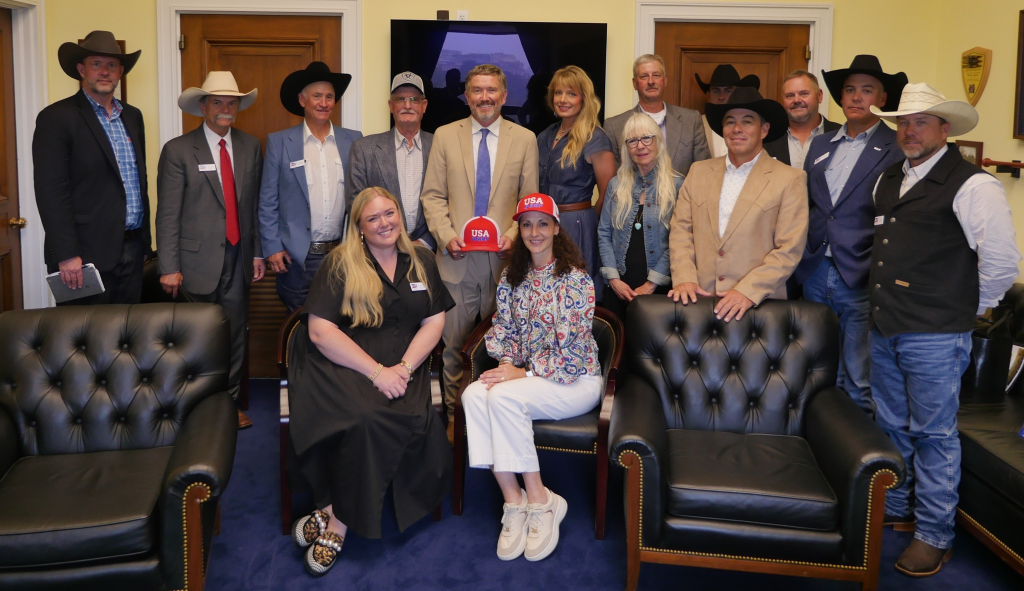
“A lot of these places we spent time correcting misinformation about COOL. The senators know about the bill coming in January to correct the USA label on re-packaged beef (prohibiting a USA label on imported and re-packaged beef), but they didn’t understand that it still won’t require any labels on either foreign or domestic beef.
“We explained to them that consumers are misled by the ‘USDA’ label on beef – they think it means the beef is a product of the USA,” he said. “We also had to explain to them that we represent the cattle industry, not the beef industry.”
Hyde and a couple other ranchers visited with the U.S. Trade Representative’s office. “They said ‘we have an issue in this country that beef is too high.’ So we said, ‘what are you comparing it to? Let’s go get a cup of coffee or a bag of Doritos.'”
The R-CALF members voiced their support for the current tariffs and explained to the trade representative that if more imported beef is dumped on the market to lower cattle prices, it could compel more people to sell out, thus lowering the nation’s cattle numbers even further.
The ranchers also shared their concerns about increased beef imports. “Imports have doubled in less than 10 years. Brazil filled their tariff rate quota in 17 days this year, and the 26 percent over quota mark up is still too cheap. Some say the imports are just lean beef that adds value to our U.S. trimmings (fat) but we showed them data proving that significant primals, cuts and offal are also being imported.
“One staffer told us, it’s great to get a perspective from a producer instead of a paid political lobbyist,” said Hyde.
NCBA
The National Cattlemen’s Beef Association has been active in the nation’s capital as well.
NCBA Past-President and California rancher Kevin Kester spoke at a House Republican Conference press event Sept. 16, 2025, on the importance of the One Big Beautiful Bill for America’s cattle farmers and ranchers. Kester thanked House Leadership and President Donald J. Trump for securing tax relief and Farm Bill provisions in the One Big Beautiful Bill.
Kester was joined at the press conference by Speaker of the House Mike Johnson, House Majority Leader Steve Scalise, House Majority Whip Tom Emmer, and Congressman Tony Wied. California ranchers and NCBA members Tony Toso and Mike Williams, along with Iowa cattle producer Eythan Blair attended the press conference as well.
NCBA Executive Director of Government Affairs Kent Bacus testified at a Section 301 investigation hearing on Sept. 3, 2025, regarding Brazil’s trade practices. The hearing, convened by the Office of the U.S. Trade Representative and held at the U.S. International Trade Commission, examined the Brazilian government’s trade policies and actions for unreasonable, discriminatory harm to U.S. commerce. According to an NCBA news release, Bacus focused attention on Brazil’s restrictions on U.S. beef and long-standing concerns with the Brazilian government’s track record of food safety and animal health.
“NCBA is extremely supportive of President Trump holding Brazil accountable by levying upwards of 76 percent tariffs on Brazilian goods headed to the U.S. market. This is a good first step, but the administration must continue to hold Brazil accountable for its trade barriers on U.S. beef and its lack of transparency and accountability,” said Bacus. “NCBA urges the Trump administration to suspend beef imports from Brazil until a thorough audit and inspection process proves that Brazil can meet an equivalent level of food safety and animal health.”
In the past five years, Brazil has sold $4.45 billion of beef to American consumers but has failed to reciprocate meaningful access for U.S. beef by implementing burdensome technical barriers. Meanwhile, Brazil’s failure to report serious animal health cases in a timely manner has raised questions about their food safety and animal health standards. Brazil has repeatedly waited weeks, months, or even years to report cases of atypical bovine spongiform encephalopathy (BSE) while using the delay to sell more product, said the NCBA news release.


